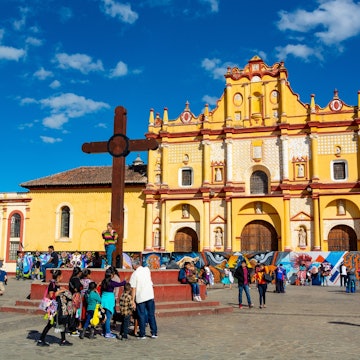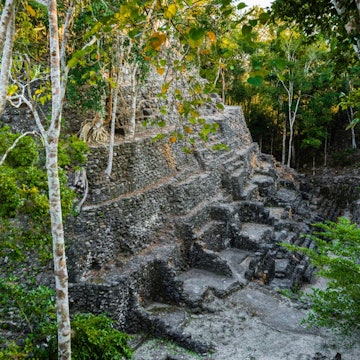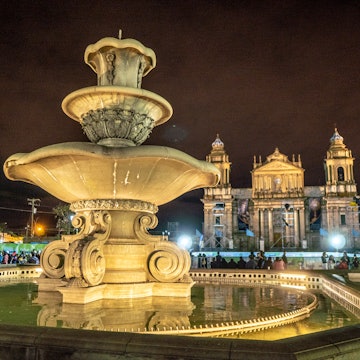

Antigua, Guatemala, with Volcán Agua in the distance. davesimon/Shutterstock
Antigua continually melts visitors’ hearts. For some, the magic is in the quaint cobblestone streets, painted walls, tiled rooftops or contrast of the alleys with the blueness of the sky. For others, it’s the ruined cathedrals, churches and convents and their testament to nature’s power and the flimsy human endeavors it can so easily reclaim.
Still others are seduced by the wealth of different foods from around the world, delicious salsas, freshly made chocolate, and rich coffee, or the chance to meet cosmopolitan people from all over the world in coffee shops and cute cafes.
All of the city’s magic has made Antigua (not surprisingly) one of Guatemala’s most-visited spots, so expect crowds, especially during religious festivals.
It’s also a delightful base for day trips and overnights to surrounding countryside towns, and for outdoor activities. The city is cradled between several beautiful volcanoes, one of which, Fuego, is active and puffs out billows of ash several times a day. There are hiking opportunities and more sedentary thrills, like exploring quaint villages and delightful markets, visiting rich historical landmarks and witnessing plant and animal life that you might not otherwise get to see.
These are the best things to do in and around Antigua.

1. Get a bird’s-eye view of Antigua
Cerro de la Cruz (Hill of the Cross) offers a sweeping view of the entire city, with the incredible, immense Volcán Agua as a backdrop – so perfect it could be the opening scene in a movie. But the view is only part of the experience, especially if you choose to hike from your spot in town. Morning offers the best light, and you’ll surely see photo- and selfie-worthy walls, buildings and rooftops as you make your way toward the hill. At the edge of town, the road turns slightly upward and the cerro (hill) begins. A cement pathway guides you in a series of switchbacks and turns through a delightfully shaded forest until you finally reach the top. It’s also easily accessible by vehicle, though it’s a tooth-jarring ride in a tuk-tuk (three-wheeled motor vehicle) thanks to the cobblestones.
The park has cement seating arranged in an amphitheater style, and the cruz (cross) has a commanding view of the city – standing as if a person, arms outstretched, is looking down and blessing the town below. Look for the photogenic set of quetzal wings and take a selfie, make friends with other travelers or just marvel at the view.
Planning tip: Restroom facilities have been under renovation and may be closed. Also, the area is remote, so it’s wise to ask at your hotel if there are safety concerns, especially in the early morning or late in the day when you might be the only one up there.

2. Witness the beauty of magnificent destruction
One of Antigua’s many charms is its multitude of ruined churches, cathedrals, convents and monasteries. Ironically, the terrible tragedies that befell these buildings are what make these spots so popular today. Even shortly after Spanish colonization, the city was a nexus for Catholicism, with dozens of different denominations setting up here over the span of just a few centuries. Soon the entire city was filled with beautiful structures, each sporting delicate decorative work and European-style lofty vaults and arches.
That all came crashing down – literally – in a series of earthquakes in the 1700s and 1800s; the disasters were so severe the government fled from Antigua to Guatemala City. Thousands of people lost their lives, and thousands more were maimed and wounded. The structures lay in ruins, a testament to the destructive force of nature. Many of these buildings were never rebuilt, and many were not even cleared away.
Today, they are tourist attractions, and there’s an undeniable majesty about them, something poignant and telling in the giant pieces of brick and stone, the ornate decorations split and fragmented, with Iglesia y Convento de la Recolección and the Arco de Santa Catalina the absolute standouts.
Planning tip: Several of these are free to enter; most require a nominal fee. Some have Spanish- or English-speaking guides who can explain some of the key features, often shedding light on structures or rooms that would be oddly mysterious otherwise.


3. Make your own chocolate
The word “chocolate” comes from the Maya “chocol-ha”: a bitter, chocolate-based drink often spiced with chili and black pepper. First, the roasted beans were crushed into a dry paste, with water and spices added until it was the right consistency to drink. Residue has been found in vessels that are hundreds, even thousands of years old. The concoction was originally reserved only for the ruling elites who could afford the luxury.
Over time, this liquid got sweetened, first with honey and then – as today – with sugar, and the name slowly morphed into the word “chocolate” that we all recognize. This sacred food for the Maya and the complicated process have been handed down through the centuries, making its production a key staple of Guatemala’s export trade.
Chocolate addicts will want to tie on an apron and get their hands dirty in a class about all things chocolate, like the ones at Ek Chuah or ChocoMuseo. Learn the history, how the pods are harvested and what the different types are. Open pods and extract the beans. Some classes (the longer ones) will even show you how to roast your own, and while the fermentation isn’t possible in a few hours, you’ll have a sense of how that happens as well.
Once the beans have been extracted from the pods and roasted, the fun part happens: grind them, either with a molcajete (mortar) or machine (the easy way) until a paste forms. This paste, though bitter, is what is used to make chocolate bars or – in the case of the Maya – the sacred drink of chocol-ha.

4. Watch lava erupting before your eyes
Hiking to the summit of Volcán Acatenango is one of the most incredible activities Guatemala has to offer, and for many visitors it’s a must-do even if they’re not avid hikers. The hike traverses four ecosystems to reach the summit, which is a nothing-to-sneeze-at 3976m. Inexperienced hikers can tackle it but may find that it’s one of the most strenuous, exhausting, physically challenging things they’ve ever done. Take special care to wear broken-in footwear, as your feet will swell during the hike and blisters can be excruciating.
As with many volcanoes, the hike starts and then goes up, up, up, getting harder and steeper pretty much until you reach the summit. There are places to stop and rest, but as you’ll likely be with a larger group, you’ll need to keep pace. As difficult as it is, the reward at the summit is spectacular; you’ll be looking down on Fuego’s erupting peak, just a mere ridge away. At night, the glowing lava spurts out of the cone and seems so close you can touch it.
Typical agency prices for day hikes are around 800 Guatemalan quetzal (Q), including lunch and 5am transport to the trailhead in the village of La Soledad. Overnight hikes are another option, camping just below the treeline then ascending to the summit the following morning. Prices vary based on what’s included (some tours don’t guarantee that everyone will even have their own sleeping bag), but you can expect to pay Q1000 per person for the overnight stay, easily more if amenities (such as private bunks at the base camp) are included.
Planning tip: If you hike Volcán Acatenango and camp overnight, chances are your guide will offer you an option to cross the ridge to Volcán Fuego. It’s tempting, and social media is full of incredible photos of lava erupting, and who wants to miss out on that? Unfortunately, this brings you well into the kill zone for a major eruption and you’re literally playing with fire. Know that if you go, it is extremely dangerous and no scientist would recommend getting that close.

5. Immerse yourself in language
Learning any language is best done by immersing yourself in it, and Antigua’s many language schools offer the chance to stay, eat, speak and even dream in Spanish, letting you maximize your education. Locals often will continue speaking Spanish with you even long after you’ve made it obvious as a foreigner that English is likely the faster, easier way to get points across, which aids greatly in language development. Guatemalans seem to understand that if you’re there to learn Spanish, that’s the language they should reply with, even if their English is just as good as yours, and it often is! What this means is that you can deeply and fully immerse yourself in Spanish.
There are literally dozens of potential schools, and choosing the right one can be a challenge. Look for ones that fit your budget, first of all, and that offer the level of instruction you need and, ideally, offer homestay programs where you can spend time being part of a local Guatemalan family. Being as engaged as possible in the language will deepen the bond, help your language skills, and who knows, perhaps lead to lifelong friendships as well.
Some good options include Antigüeña Spanish Academy, with highly rated classes taught in a lush garden setting at a level that matches your needs; Ixchel Spanish School, which offers excellent instruction and can arrange for homestays with local families as well; and Don Pedro de Alvarado, with low teacher-to-student ratios and classes online as well as in person.
Planning tip: Spanish is the official language of Guatemala, but the country has an astonishing 23 other languages that are actively spoken – 21 Maya dialects and two non-Maya ones. You may spend a month or two brushing up on Spanish only to travel around and realize you’re not able to understand anything people are saying.

6. Enjoy a welcoming after-dark vibe
A night on the town in Antigua can mean anything from quietly enjoying wine or an aperitif with friends to hitting a dance club and meeting rowdy strangers. One of the best aspects of nightlife here, whether it’s at a bar or club, is just how international it is. Pick five people at random and they’re likely all from different countries, possibly different continents.
There’s a lot happening in and around the main plaza, and some may just enjoy the view with a glass of wine in hand. The section just south of the plaza on 5th Avenida is a nice spot to start, with several options right here to hop to or from. From here, turn west and check out options on 6 Calle Poniente (6th St). West of the plaza, dance clubs will have you up until 1am, possibly later on weekends, but you won’t find things open all night the way you do in places like Guatemala City.
Check out Casa Escobar for delightful cocktail creativity, bartenders who enjoy a challenge and a view of Volcán Agua. Other great choices include Casa Troccoli, with an ambiance that can’t be beat; Charleston, a speakeasy that serves wild, over-the-top cocktails from behind a wall in a faux men’s clothing store; and El Ilegal, a chill, LGBTQ-friendly spot where you can grab great cocktails and listen to live music.
Planning tip: LGBTQ+ travelers will find that while some spots specifically mention they are friendly, there’s a general acceptance here of all types and it’s unlikely any Antigua bars or clubs would make you feel unwelcome.

7. Visit Guatemala’s quaint second capital
Just a short car ride from Antigua is the quaint, quiet town of Ciudad Vieja, once the capital of the country. It makes for a nice day trip out of its larger neighbor and has a lovely main plaza overlooked by the brilliant white Parroquia Purísima Concepción, founded in 1534, with ornate decoration on the exterior and a simple interior that’s worthy of a peek. The town was flooded in 1541 when Volcán Agua’s lake burst through the crater and emptied in a deluge, destroying everything below. It was such a catastrophic disaster that the entire seat of government was shifted from here to nearby Antigua.
On September 1, a beautiful Virgin of Dolores statue is paraded through the streets, to much sanctity, fanfare and merriment. Behind the church you’ll enjoy checking out a lively produce market, refreshingly aimed at locals rather than tourists. Find fresh corn, grab chilies picked hours before and get a bag of crispy green beans, but don’t expect to find tourist souvenirs.
Like many towns, Ciudad Vieja has a public washing station, several plazas and a quaint, solemn cemetery, with a warren of pastel-colored mausoleums, crosses and monuments. While here, check out the combination museum, market and workshop that is the Casa del Tejido Antiguo, where you can find demonstrations of backstrap loom weaving techniques, as well as learn about the designs woven into the fabrics. (They’ll even pick you up in Antigua if you make a reservation!)
Detour: Not too far away, between San Antonio Aguas Calientes and Ciudad Vieja, is Valhalla Macadamia Farm, where you can tour the tree farm and learn everything you want to know about the world’s most luxurious nut. Over 300 species are grown here, and the shop sells oils, cosmetics and (of course) nuts.

8. Roast marshmallows on lava
If you’ve ever made s’mores at a campfire after a long day of hiking, you’ll love the chance to roast marshmallows over hot lava rocks atop Volcán Pacaya. This volcano erupted spectacularly in March 2020, sending rivers of molten rock pouring down its sides; rock that’s still warm, even years later.
Today, there are no glowing molten rivers, but it’s still a delightful hike. You’ll be looking down at a lovely pastoral valley, with Fuego puffing mightily in the background, assuming the day is clear and there aren’t any clouds. Closer to you, you’ll see the stark fresh lava flows that scar the fields and farmland, so fresh that no vegetation has grown on them yet. Moderately fit hikers can expect to get to the summit in under 2 hours. Less-active travelers can rent mules or horses for the journey, and at the top your guide will pull out the sticks and marshmallows and you get to hunt around for a spot still hot enough to toast them. It’s delightful entertainment, especially with kids.
If you feel like something a little more substantial, there’s even a pizza oven up here, where you can purchase what might be the world’s most expensive pizza – Q421 for a small pie, Q651 for a larger one.
Planning tip: This lava is razor sharp, and you do not want to fall. Make sure you have good, sturdy footwear and take your time walking across the lava flow. After roasting marshmallows or eating a slice of pizza, most will continue hiking and summit the nearby peak of Cerro Hoja de Queso, which overlooks the lovely valley below. After that, it’s a steep and somewhat manure-strewn descent, courtesy of the mules.
This article was adapted from Lonely Planet’s Central America guidebook, published in October 2025.













